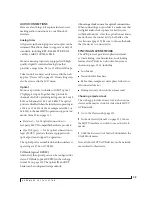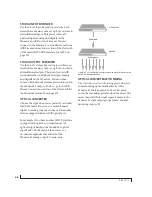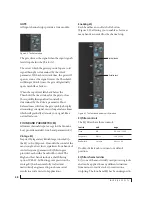
W O R K I N G W I T H H O S T A U D I O S O F T W A R E
53
REDUCING MONITORING LATENCY
Monitoring latency
is a slight delay caused by
running an input signal through your host audio
software and back out. For example, you might
hear it when you drive a live guitar input signal
through an amp modeling plug-in running in your
audio sequencer.
This delay is caused by the amount of time it takes
for audio to make the entire round trip through
your computer, from when it first enters an input
on the Monitor 8, passes through the interface
hardware into the computer, through your host
audio software, and then back out to an output.
Monitoring through the Monitor 8
If you don’t need to process a live input with
plug-ins, the easiest way to avoid monitoring
latency is to disable your DAW’s live monitoring
feature and instead use the digital mixer in the
Monitor 8 to route the input directly to your
outputs. For details, see “Mixing tab” on page 15.
The mixer in the Monitor 8 even provides zero
latency effects processing (EQ, compression and
reverb), which can be applied to the signal.
Direct hardware playthrough / Direct ASIO
monitoring
When managing your live monitor mix through
the Monitor 8 mixer, remember to disable your
DAW’s live monitoring features, so that you won’t
hear record-enabled tracks in your DAW. Also note
that the Monitor 8 does not support
Direct
Hardware Playthrough
in Digital Performer, or the
Direct ASIO Monitoring
feature (or similar) offered
and other DAWs, which lets you control no-latency
hardware monitoring from within the host
application. Instead, you can use the MOTU AVB
Control web app mixer (“Mixing tab” on page 15)
to make these live monitoring connections
manually.
If you don’t require any effects processing on the
input signal (no reverb or compression, for
example), all this takes is one click in the routing
grid to route the input being recorded to the output
you are using for monitoring.
If you are recording a mono input that you’d like to
monitor in stereo, or if you need to apply effects to
the monitored signal, you can simply route the
input to the mixer in the Monitor 8. This is done by
opening the
Mix In
group in the
Outputs
column
along the left side of the grid, and clicking the tile at
the intersection of the input’s column and the
desired mixer input’s row. Once routed to the
mixer, use the input channel, reverb bus, and
monitor bus in the mixer to apply effects as desired,
and perhaps include other channels to the mix, and
then assign the monitor bus output in the routing
grid to the output you are using for monitoring.
In either case (routing directly in the grid or
routing through the mixer), be sure to maintain the
input’s connection to the computer as well, so the
input signal can be recorded in your host software.
In other words, you’ll want to make sure there are
two tiles enabled in the input’s column in the grid:
one tile for the connection to the computer and
another tile for your monitoring output (or a mixer
input, if you are using the mixer to apply effects). If
you need to route the input signal to other
destinations, too, you can certainly do so (you can
route the input to multiple destinations).
Monitoring through your host audio software
If you
do
need to process a live input with host
software plug-ins, or if you are playing virtual
instruments live through your MOTU audio
hardware, you can significantly reduce latency by
adjusting the audio buffer setting in your host
audio software, as explained in the next section.
☛
It is important to note that monitoring delay
has no effect on the recording, or playback, of
audio data from disk. The actual recording and
Содержание Monitor 8
Страница 5: ...Part1 GettingStarted ...
Страница 6: ......
Страница 8: ...8 ...
Страница 26: ...P A C K I N G L I S T A N D S Y S T E M R E Q U I R E M E N T S 26 ...
Страница 30: ...S O F T W A R E I N S T A L L A T I O N 30 ...
Страница 41: ...Part2 Usingthe Monitor8 ...
Страница 42: ......
Страница 56: ...W O R K I N G W I T H H O S T A U D I O S O F T W A R E 56 ...
Страница 69: ...Part3 Appendices ...
Страница 70: ......
Страница 74: ...A P P E N D I X B A U D I O S P E C I F I C A T I O N S 74 ...
Страница 75: ...APPENDIX 75 C Mixer Schematics MONO INPUT CHANNEL ...
Страница 76: ...A P P E N D I X C M I X E R S C H E M A T I C S 76 STEREO INPUT CHANNEL ...
Страница 77: ...A P P E N D I X C M I X E R S C H E M A T I C S 77 GROUP BUS ...
Страница 78: ...A P P E N D I X C M I X E R S C H E M A T I C S 78 MONITOR BUS ...
Страница 82: ...A P P E N D I X E O S C S U P P O R T 82 ...






























